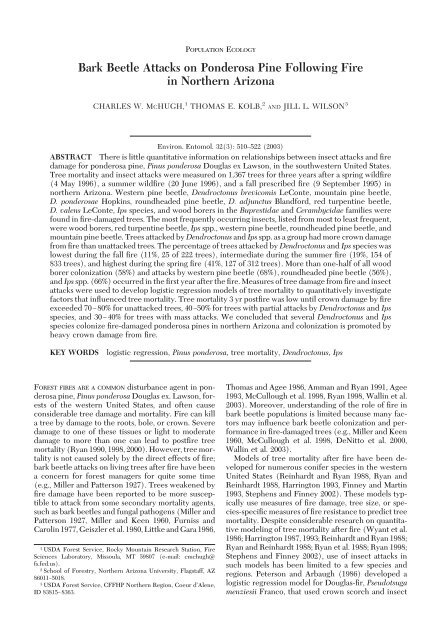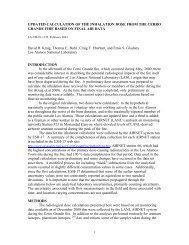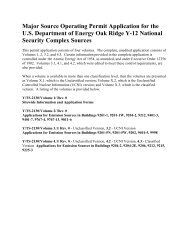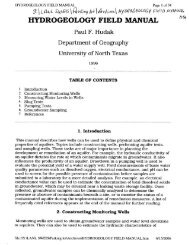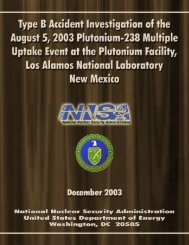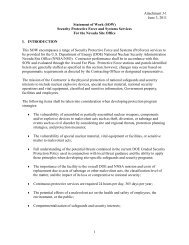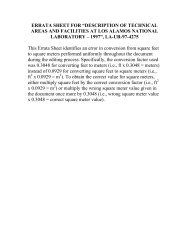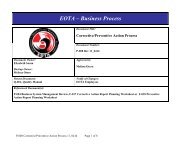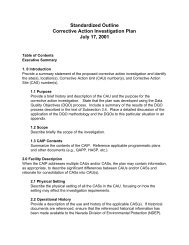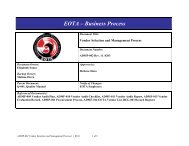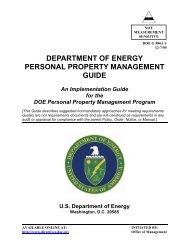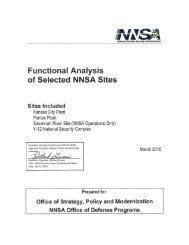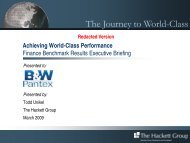Bark Beetle Attacks on Ponderosa Pine Following Fire in Northern ...
Bark Beetle Attacks on Ponderosa Pine Following Fire in Northern ...
Bark Beetle Attacks on Ponderosa Pine Following Fire in Northern ...
You also want an ePaper? Increase the reach of your titles
YUMPU automatically turns print PDFs into web optimized ePapers that Google loves.
512 ENVIRONMENTAL ENTOMOLOGY Vol. 32, no. 3Fig. 1. Study sitelocati<strong>on</strong>s. TheSideStudy Area (spr<strong>in</strong>g wildÞre) burned <strong>in</strong> thespr<strong>in</strong>g 1996, theBridger Knoll Study Area(summer wildÞre) burned <strong>in</strong> the summer 1996, and the Dauber Study Area (fall prescribed Þre) burned <strong>in</strong> the fall 1995.<strong>Fire</strong> Behavior and Intensity. Becauseof theopportunisticnature of this study, direct observati<strong>on</strong>s of Þrebehavior characteristics, such as ßame length, are notavailable. Instead, BEHAVE versi<strong>on</strong> 4.4 (Andrews1986), a Þre behavior predicti<strong>on</strong> model, was used topredict thepossiblerangeof Þrecharacteristics thatoccurred across each site. We used BEHAVE to predictÞrebehavior <strong>in</strong> theßam<strong>in</strong>g fr<strong>on</strong>t based <strong>on</strong> thefollow<strong>in</strong>g <strong>in</strong>puts: <strong>Northern</strong> Forest <strong>Fire</strong> Laboratory(NFFL) Þre behavior fuel models (Anders<strong>on</strong> 1982),percent fuel moisture c<strong>on</strong>tent of the 1-, 10-, and 100-htime lag fuels (Fosberg and Deem<strong>in</strong>g 1971, Rothermel1983), midßame w<strong>in</strong>dspeed (Rothermel 1983), andpercent slope (Table 1). Required fuel moisture andw<strong>in</strong>d data for the model were obta<strong>in</strong>ed from USDAForest Service records for each Þre.<strong>Fire</strong>l<strong>in</strong>e <strong>in</strong>tensity, because of its relati<strong>on</strong> to ßamelength, is best used to express Þre effects <strong>on</strong> materialsaffected by c<strong>on</strong>vective heat<strong>in</strong>g, such as foliage (VanWagener 1973, F<strong>in</strong>ney and Mart<strong>in</strong> 1993). Agee (1993)provides ranges of Þrel<strong>in</strong>e <strong>in</strong>tensity for surface Þre(0Ð258 kW m 1 ), understory Þre (258Ð2,800 kWm 1 ), and crown Þre(2,800 kW m 1 ). Based <strong>on</strong>thesecriteria, thefall Þrewas primarily a surfaceÞrethat reached the crowns of occasi<strong>on</strong>al trees, whereasthe spr<strong>in</strong>g and summer Þres varied from surface tocrown Þres (Table 1).The fall Þre was a prescribed burn of both naturaland activity fuels (fuels generated from logg<strong>in</strong>g activity).Strip igniti<strong>on</strong>s designed to create strip headÞres were <strong>in</strong>itially used to ignite the area. Later <strong>in</strong>tothe igniti<strong>on</strong> phase, light<strong>in</strong>g patterns were changed tocause low-<strong>in</strong>tensity back<strong>in</strong>g Þres. The 1-, 100, 100-, and1,000-h time-lag moisture classes (Fosberg and Deem<strong>in</strong>g1971, Rothermel 1983) were with<strong>in</strong> normal rangesfor prescribed burn<strong>in</strong>g and w<strong>in</strong>ds were light (Table 1).Table 1. Fuel model, fuel moisture, slope, and w<strong>in</strong>dspeed values used <strong>in</strong> the fire behavior model BEHAVE to predict the range offire characteristics experienced across the study sitesParameter Fall prescribed Þre Spr<strong>in</strong>g wildÞre Summer wildÞre<strong>Fire</strong>l<strong>in</strong>e <strong>in</strong>tensity (kW m 1 ) 44 to 234 338 to 3,726 118 to 4,132Fuel model a 9,11 2,9 2,91-h fuel moisture c<strong>on</strong>tent (%) 9 3 210-h fuel moisture c<strong>on</strong>tent (%) 10 4 3100-h fuel moisture c<strong>on</strong>tent (%) 14 5 41,000-h fuel moisture c<strong>on</strong>tent (%) 18 8 6Slope(%) 5 5 5Ð30W<strong>in</strong>dspeed b (km h 1 ) 3.2Ð8.0 8.0Ð12.9 3.2Ð32.2a <strong>Follow<strong>in</strong>g</strong> Anders<strong>on</strong> (1982).b Midßame w<strong>in</strong>dspeed (Rothermel 1983).
514 ENVIRONMENTAL ENTOMOLOGY Vol. 32, no. 3Table 2. Summary statistics for three fires <strong>in</strong> northern Ariz<strong>on</strong>a for diameter breast height (DBH) and crown damage variables (means SEM). ANOVA was performed to test for differences <strong>in</strong> DBH and crown damage am<strong>on</strong>g firesFall prescribed Spr<strong>in</strong>g wildÞre Summer wildÞreANOVA resultsdf F PDBH (cm) 24.2a 0.44 40.1b 1.20 51.7c 0.57 2, 1364 256.760 0.001Crown scorch (%) 45.9%a 2.23 55.3%b 1.78 27.3%c 1.07 2, 1364 102.952 0.001Crown c<strong>on</strong>sumpti<strong>on</strong> (%) N/A 10.3%a 1.17 4.4%b 0.55 1, 1143 26.406 0.001Total crown damage(%) 45.9%a 2.23 65.6%b 1.86 31.5%c 1.22 2, 1364 113.367 0.001Means followed by different letters are signiÞcantly different based <strong>on</strong> FisherÕs protected LSD test at 0.05.each Þre. Logistic regressi<strong>on</strong> models of tree mortalitywere developed for each Þre us<strong>in</strong>g SPSS Versi<strong>on</strong> 8.0(SPSS 1998). The <strong>in</strong>dependent variables c<strong>on</strong>sideredfor these models were DBH, crown scorch, crownc<strong>on</strong>sumpti<strong>on</strong>, TCD, and IAR. Data <strong>on</strong> IAR werepooled over all Dendroct<strong>on</strong>us and Ips species for eachtree because most trees were attacked by several <strong>in</strong>sectspecies. Also, the small number of occurrences of<strong>in</strong>dividual <strong>in</strong>sect species made pool<strong>in</strong>g over speciesthe<strong>on</strong>ly feasibleapproach <strong>in</strong> our model<strong>in</strong>g.For each Þre, <strong>in</strong>dependent variables were screenedfor their <strong>in</strong>ßuence <strong>on</strong> tree mortality by compar<strong>in</strong>gvalues for dead versus live trees us<strong>in</strong>g two samplet-tests. Screen<strong>in</strong>g c<strong>on</strong>sisted of us<strong>in</strong>g <strong>on</strong>ly <strong>in</strong>dependentvariables that differed between live and dead trees(P 0.10), were not str<strong>on</strong>gly correlated (r 0.50)with other <strong>in</strong>dependent variables, and were signiÞcantly(P 0.10) related to tree mortality. Modelgoodness-of-Þt was assessed based <strong>on</strong> the follow<strong>in</strong>gdiagnostic statistics for each model: Studentized residual,Deviance and CookÕs distance values, and a testof the model null hypothesis that all model coefÞcientsare0 except thec<strong>on</strong>stant, which is comparableto theoverall F test for regressi<strong>on</strong> (Hosmer and Lemeshow1989, Norusis 1994). The model used to predict treemortality was:P m 1/(1 exp((b 0 b 1 x 1 ... b n x n )))where P m is theprobability of treemortality, b 0 ,b 1 ,and b n are regressi<strong>on</strong> coefÞcients, and x 1 and x n arerepresentative <strong>in</strong>dependent variables.Receiver operat<strong>in</strong>g characteristic (ROC) curveswere used to assess the overall accuracy for eachlogistic regressi<strong>on</strong> model (Saveland and Neuenschwander1990, F<strong>in</strong>ney and Mart<strong>in</strong> 1993, Regelbruggeand C<strong>on</strong>ard 1993, F<strong>in</strong>ney 1999, Stephensand F<strong>in</strong>ney 2002). TheROC curveis a plot of theprobability of a truepositivepredicti<strong>on</strong>, or hit rate(tree is classiÞed as dead when it is dead), versus theprobability of a falsepositive, or falsealarm rate(typeII error; tree is classiÞed dead when it is alive) byvary<strong>in</strong>g the decisi<strong>on</strong> criteri<strong>on</strong> from 0 to 1 for groupmembership (Saveland and Neuenschwander 1990,Bradley 1996). TheROC curvevaluecan vary from0.50, which is no better than chance, to 1.0, <strong>in</strong> whichall predicti<strong>on</strong>s are correct (Saveland and Neuenschwander1990, Swets 1996). ROC values between0.50 and 0.70 <strong>in</strong>dicate low accuracy, values between0.70 and 0.90 <strong>in</strong>dicatemoderateaccuracy, and values0.90 <strong>in</strong>dicate very high accuracy (Swets 1996).ResultsTree Characteristics by <strong>Fire</strong>, Insect Attack Level,and Mortality Group. Average tree DBH was signiÞcantlysmaller for thefall Þrecompared with thespr<strong>in</strong>g and summer Þres (Table 2). DBH averagedover live and dead trees was similar for attacked trees(with c<strong>on</strong>Þrmed attacks of Dendroct<strong>on</strong>us or Ips species)and unattacked trees at the fall and spr<strong>in</strong>g Þres,whereas attacked trees were signiÞcantly larger thanunattacked trees at the summer Þre (Table 3). However,for dead trees (Table 4), DBH of attacked treeswas signiÞcantly greater than unattacked trees at thefall Þre(t 2.715; df 38; P 0.010) and thesummerwildÞre(t 2.453; df 114; P 0.016), but not at thespr<strong>in</strong>g wildÞre(t 1.296; df 99; P 0.198). For livetrees (Table 4), DBH was signiÞcantly larger for attackedversus unattacked trees <strong>on</strong>ly at the summer Þre(t 2.822; df 715; P 0.005). Live unattacked treeshad signiÞcantly larger DBH than dead unattackedtrees at the fall and spr<strong>in</strong>g Þres, but not at the summerÞre(Table4).Attacked trees were divided <strong>in</strong>to those that died bytheend of thestudy and thosethat lived. Attacked liveand dead trees had similar DBH at the fall and summerÞres, whereas live attacked trees (i.e., attacked but stillliv<strong>in</strong>g at theend of thestudy) weremarg<strong>in</strong>ally largerthan dead attacked trees at the spr<strong>in</strong>g Þre (Table 4).Attacked live trees were attacked <strong>on</strong>ly by red turpent<strong>in</strong>ebeetle, whereas attacked dead trees usually wereattacked by primary bark beetles (e.g., western p<strong>in</strong>ebeetle, mounta<strong>in</strong> p<strong>in</strong>e beetle, roundheaded p<strong>in</strong>e beetle)or Ips species <strong>in</strong> comb<strong>in</strong>ati<strong>on</strong> with wood borers.Average crown scorch differed signiÞcantly am<strong>on</strong>gÞres and was lowest <strong>on</strong> the summer Þre, <strong>in</strong>termediate<strong>on</strong> thefall Þre, and highest <strong>on</strong> thespr<strong>in</strong>g Þre(Table2). Attacked trees at all Þres had signiÞcantly morecrown scorch than unattacked trees (Table 3), andattacked dead trees had signiÞcantly more crownscorch than attacked live trees (Table 4). Crownscorch of unattacked dead trees was signiÞcantlyhigher than unattacked live trees for all Þres and wasnearly equal to crown scorch levels of attacked deadtrees (Table 4).Crown c<strong>on</strong>sumpti<strong>on</strong> occurred <strong>on</strong>ly <strong>in</strong> the spr<strong>in</strong>gand summer Þres, and was signiÞcantly lower <strong>in</strong> thesummer Þrecompared with thespr<strong>in</strong>g Þre(Table2).Crown c<strong>on</strong>sumpti<strong>on</strong> of attacked trees was signiÞcantlyhigher than unattacked trees for spr<strong>in</strong>g andsummer wildÞres, and crown c<strong>on</strong>sumpti<strong>on</strong> of attacked
June2003 MCHUGH ET AL.: BARK BEETLE ATTACKS 515Table 3. Means (SEM) of tree variables by seas<strong>on</strong> of fire (fall, spr<strong>in</strong>g, summer) for attacked and unattacked p<strong>on</strong>derosa p<strong>in</strong>es 3 yrpostfire <strong>in</strong> northern Ariz<strong>on</strong>a. P values are results of t-tests between attacked versus unattacked trees. Attacked trees have attacks byDendroct<strong>on</strong>us and Ips species, and unattacked trees do notSeas<strong>on</strong>/variable Attacked Unattacked t PFall n 25 n 197 df 220DBH (cm) 25.8 1.53 24.1 0.46 1.280 0.202Crown scorch (%) 58.0 6.81 44.5 2.35 1.927 0.055Crown c<strong>on</strong>sumpti<strong>on</strong> (%) 0 (0) 0 (0) N/A N/ATotal crown damage(%) 58.0 6.81 44.5 2.35 1.927 0.055Insect attack rat<strong>in</strong>g 1.3 (0.01) 0 (0) 39.832 0.001Spr<strong>in</strong>g n 127 n 185 df 310DBH (cm) 40.6 2.05 39.7 1.45 0.334 0.738Crown scorch (%) 66.2 2.42 47.8 2.35 5.286 0.001Crown c<strong>on</strong>sumpti<strong>on</strong> (%) 18.6 2.25 4.5 1.03 6.274 0.001Total crown damage(%) 84.8 1.73 52.4 2.48 9.774 0.001Insect attack rat<strong>in</strong>g 1.4 0.004 0 (0) 39.211 0.001Summer n 154 n 679 df 831DBH (cm) 55.8 1.32 50.7 0.63 3.515 0.001Crown scorch (%) 46.7 2.68 22.8 1.09 9.116 0.001Crown c<strong>on</strong>sumpti<strong>on</strong> (%) 7.1 1.54 3.7 0.58 2.419 0.016Total crown damage(%) 53.8 2.91 26.5 1.27 9.123 0.001Insect attack rat<strong>in</strong>g 1.2 0.003 0 (0) 82.938 0.001trees <strong>in</strong> the spr<strong>in</strong>g Þre was 2.6 times higher than attackedtrees <strong>in</strong> the summer Þre (Table 3). Crownc<strong>on</strong>sumpti<strong>on</strong> of dead trees was signiÞcantly greaterthan crown c<strong>on</strong>sumpti<strong>on</strong> of live trees regardless ofattack level (Table 4).TCD was signiÞcantly different am<strong>on</strong>g Þres and waslowest <strong>in</strong> the summer Þre, <strong>in</strong>termediate <strong>in</strong> the fall Þre,and greatest <strong>in</strong> thespr<strong>in</strong>g Þre(Table2). For all Þres,TCD was signiÞcantly higher for attacked trees versusunattacked trees (Table 3). For all Þres, TCD of deadtrees was signiÞcantly higher than live trees regardlessof attack level (Table 4).The percentage of trees attacked by Dendroct<strong>on</strong>usand Ips species was lowest <strong>in</strong> the fall Þre (11%, 25 of222 trees), <strong>in</strong>termediate <strong>in</strong> the summer Þre (19%, 154of 833 trees), and highest <strong>in</strong> the spr<strong>in</strong>g Þre (41%, 127of 312 trees). The average IAR was nearly equal for allÞres and ranged from a low of 1.2 <strong>in</strong> the summer Þreto a high of 1.4 <strong>in</strong> thespr<strong>in</strong>g Þre(Table3). Dead treeshad a signiÞcantly higher IAR than live trees for allÞres (Table 4).Distributi<strong>on</strong> and Occurrence of Insect Taxa. Total<strong>in</strong>sect occurrence pooled over all Þres was lowest <strong>in</strong>all years for mounta<strong>in</strong> p<strong>in</strong>e beetle and roundheadedp<strong>in</strong>e beetle (Fig. 2). Mounta<strong>in</strong> p<strong>in</strong>e beetle was notfound <strong>on</strong> any trees <strong>in</strong> the fall or spr<strong>in</strong>g Þres and <strong>on</strong> <strong>on</strong>lyeight trees <strong>on</strong> the summer Þre 3 yr postÞre. Twenty-Þve percent of all trees attacked by mounta<strong>in</strong> p<strong>in</strong>ebeetle <strong>on</strong> the summer Þre were attacked <strong>in</strong> the ÞrstpostÞre year, 1997, and attacks <strong>in</strong>creased gradually <strong>in</strong>1998 and 1999 (Fig. 2). The mean DBH for treesattacked by mounta<strong>in</strong> p<strong>in</strong>e beetle <strong>in</strong> the summer Þrewas 60.2 cm with a mean TCD of 71%. Few trees wereattacked by roundheaded p<strong>in</strong>e beetle for the spr<strong>in</strong>g(4) and summer Þres (5), and no trees were attackedby this species for the fall Þre 3 yr postÞre. For round-Table 4. Means (SEM) of tree variables by seas<strong>on</strong> of fire (fall, spr<strong>in</strong>g, summer) for live and dead attacked and unattacked p<strong>on</strong>derosap<strong>in</strong>es 3 yr postfire <strong>in</strong> northern Ariz<strong>on</strong>a. Significance values are results of t-tests between live and dead trees for attacked and unattackedtrees. Attacked trees have attacks by Dendroct<strong>on</strong>us and Ips species, and unattacked trees do notVariableAttackedUnattackedLiveDead t P LiveDead t PFall n 14 n 11 df 23 n 168 n 29 df 195DBH (cm) 26.4 1.54 25.1 2.96 0.427 0.674 25.0 0.47 18.5 0.10 5.397 0.001Crown scorch (%) 36.4 7.23 85.5 5.62 5.119 0.001 37.6 2.322 84.5 2.96 8.187 0.001Crown c<strong>on</strong>sumpti<strong>on</strong> (%) N/A N/A N/A N/A N/A N/A N/A N/ATotal crown damage(%) 36.4 7.23 85.5 5.619 5.119 0.001 37.6 2.32 84.5 2.96 8.187 0.001Insect attack rat<strong>in</strong>g 1.0 0.00 1.6 0.152 4.748 0.001 N/A N/A N/A N/ASpr<strong>in</strong>g n 45 n 82 df 125 n 166 n 19 df 183DBH (cm) 45.6 3.44 37.8 2.52 1.830 0.070 40.8 1.52 30.5 4.31 2.186 0.030Crown scorch (%) 60.7 3.71 69.3 3.12 1.711 0.090 45.7 2.44 66.8 7.22 2.783 0.006Crown c<strong>on</strong>sumpti<strong>on</strong> (%) 9.1 2.29 23.8 3.11 3.235 0.002 1.9 0.48 26.8 7.49 8.701 0.001Total crown damage(%) 69.8 3.28 93.1 1.28 7.811 0.001 47.7 2.51 93.7 1.57 6.185 0.001Insect attack rat<strong>in</strong>g 1.02 0.002 1.7 0.005 8.703 0.001 N/A N/A N/A N/ASummer n 98 n 56 df 152 n 619 n 60 df 677DBH (cm) 55.9 1.69 55.6 2.13 0.128 0.898 52.8 0.64 47.8 2.35 1.461 0.144Crown scorch (%) 35.3 3.02 66.6 3.91 6.300 0.001 19.1 1.00 60.7 4.44 11.859 0.001Crown c<strong>on</strong>sumpti<strong>on</strong> (%) 1.4 0.63 17.1 3.73 5.349 0.001 0.695 0.19 34.8 4.65 21.813 0.001Total crown damage(%) 36.7 3.10 83.8 3.09 9.953 0.001 19.8 1.05 95.5 1.15 22.365 0.001Insect attack rat<strong>in</strong>g 1.07 0.003 1.3 0.006 3.990 0.001 N/A N/A N/A N/A
516 ENVIRONMENTAL ENTOMOLOGY Vol. 32, no. 3Fig. 2. Cumulativeoccurrenceof <strong>in</strong>sect taxa <strong>on</strong> p<strong>on</strong>derosap<strong>in</strong>e over three years (1997, 1998, 1999) after Þre <strong>in</strong>northern Ariz<strong>on</strong>a. Cumulativeoccurrenceis thenumber oftrees attacked by each <strong>in</strong>sect totaled over years. WPB western p<strong>in</strong>e beetle, MPB mounta<strong>in</strong> p<strong>in</strong>e beetle, RPB roundheaded p<strong>in</strong>e beetle, IPS Ips species, RTB redturpent<strong>in</strong>e beetle, WB wood borers <strong>in</strong> the Buprestidae andCerambycidae families. Data are pooled over fall, spr<strong>in</strong>g, andsummer Þres.headed p<strong>in</strong>e beetle, 44% of total attacks occurred <strong>in</strong>1997 with small <strong>in</strong>creases <strong>in</strong> 1998 and 1999 (Fig. 2).Mean DBH of trees attacked by roundheaded p<strong>in</strong>ebeetlewas 50.7 cm for thespr<strong>in</strong>g Þreand 62.0 cm forthe summer Þre. Mean TCD for trees attacked byroundheaded p<strong>in</strong>e beetle was 82% for the spr<strong>in</strong>g Þreand 90% for the summer Þre.Western p<strong>in</strong>e beetle was found <strong>on</strong> <strong>on</strong>ly three treesat the fall Þre, 19 trees at the spr<strong>in</strong>g Þre, and 13 trees<strong>on</strong> the summer Þre 3 yr postÞre. Sixty-eight percent oftotal attacks by this species occurred <strong>in</strong> 1997, withslight <strong>in</strong>creases <strong>in</strong> 1998 and 1999 (Fig. 2). The meanTCD of trees attacked by western p<strong>in</strong>e beetle was 92%<strong>on</strong> thespr<strong>in</strong>g Þreand 83% <strong>on</strong> thesummer Þre. All threetrees attacked by this species <strong>on</strong> the fall Þre had 100%TCD. Average DBH of trees attacked by western p<strong>in</strong>ebeetle was 22.8 cm for the fall Þre, 53.1 cm for thespr<strong>in</strong>g Þre, and 56.6 cm for the summer Þre.Only three trees <strong>on</strong> the fall Þre and n<strong>in</strong>e trees <strong>on</strong> thesummer Þre were attacked by Ips species 3 yr postÞre.However, the spr<strong>in</strong>g Þre had 50 trees attacked by Ipsspecies. For the fall Þre, 100% of all Ips attacks occurred<strong>in</strong> the Þrst postÞre year. For the spr<strong>in</strong>g Þre, 72%of all Ips attacks occurred <strong>in</strong> theÞrst postÞreyear. Forthe summer Þre, 22% of all Ips attacks occurred <strong>in</strong> theÞrst postÞre year (Fig. 2). Over all Þres, 66% of Ipsattacks occurred <strong>in</strong> 1997, with <strong>on</strong>ly slight <strong>in</strong>creases <strong>in</strong>1998 and 1999 (Fig. 2). The mean DBH of trees attackedby Ips was 18.4 cm for thefall Þre, 23.3 cm forthe spr<strong>in</strong>g Þre, and 42.4 cm for the summer Þre. Themean TCD for trees attacked by Ips was 80% for thefall Þre, 93% for the spr<strong>in</strong>g Þre, and 83% for the summerÞre.Red turpent<strong>in</strong>e beetle was the most comm<strong>on</strong> speciesof Dendroct<strong>on</strong>us at all Þres. In the fall and spr<strong>in</strong>gÞres, 95% and 87% of attacks by this species occurred1 yr postÞre (1997), whereas for the summer Þre <strong>on</strong>ly27% of attacks occurred 1 yr postÞre. Over all Þres, 56%of red turpent<strong>in</strong>e beetle attacks occurred <strong>in</strong> 1997, andattacks <strong>in</strong>creased <strong>in</strong> 1998 and 1999 (Fig. 2).Red turpent<strong>in</strong>e beetle was present more often <strong>on</strong>live than <strong>on</strong> dead trees <strong>in</strong> the fall and summer Þres. Ofthe 19 trees attacked by this <strong>in</strong>sect <strong>in</strong> the fall Þre, 14were alive and 5 were dead 3 yr postÞre. Live and deadtrees attacked by red turpent<strong>in</strong>e beetle <strong>in</strong> the fall Þrehad a similar DBH (t 1.154; df 17; P 0.142), butlive trees had a lower TCD (36%) than dead (90%)trees (t 4.300; df 17; P 0.001). In the summer Þre,127 trees were attacked by red turpent<strong>in</strong>e beetle, ofwhich 87 were alive and 40 were dead 3 yr postÞre.Similar to the fall Þre, live and dead trees attacked byred turpent<strong>in</strong>e beetle had similar DBH <strong>in</strong> the summerÞre(t 0.018; df 125; P 0.986), and live trees hadlower TCD (39%) than dead trees (82%) (t 7.673;df 125; P 0.001). Occurrence of red turpent<strong>in</strong>ebeetle <strong>on</strong> the spr<strong>in</strong>g Þre was similar between live (45)and dead (49) trees 3 yr postÞre. Aga<strong>in</strong>, DBH did notdiffer between live and dead trees attacked by redturpent<strong>in</strong>ebeetle<strong>on</strong> thespr<strong>in</strong>g Þre(t 0.867; df 92;P 0.388), and live trees had a lower TCD (70%) thandead (92%) trees (t 6.294; df 92; P 0.001).Wood borers <strong>in</strong> the Cerambycidae and Buprestidaefamilies were the most comm<strong>on</strong> <strong>in</strong>sect found at all Þres(Fig. 2). Most col<strong>on</strong>izati<strong>on</strong> by wood borers occurred<strong>in</strong> theÞrst postÞreyear (1997) for thefall (94% of allcol<strong>on</strong>ized trees) and spr<strong>in</strong>g (87% of all col<strong>on</strong>izedtrees) Þres, whereas <strong>on</strong>ly 58% of total col<strong>on</strong>izati<strong>on</strong>occurred <strong>in</strong> this year for the summer Þre. However, by1998, 98% of all wood borer col<strong>on</strong>izati<strong>on</strong> had occurred<strong>in</strong> the summer Þre. Over all Þres, 73% of all trees withwood borers were col<strong>on</strong>ized <strong>in</strong> 1997, and 98% <strong>in</strong> 1998(Fig. 2). Wood borers col<strong>on</strong>ized both live and deadtrees; however, <strong>in</strong> live trees they were generally found<strong>in</strong> dead porti<strong>on</strong>s of tree cambium as a result of girdl<strong>in</strong>gfrom Þre. In dead trees wood borers col<strong>on</strong>ized isolatedareas of dead cambium and phloem secti<strong>on</strong>s of the treebole <strong>in</strong> additi<strong>on</strong> to areas previously attacked by Dendroct<strong>on</strong>usand Ips species.Mortality Models. The logistic regressi<strong>on</strong> model developedfor the fall prescribed Þre was highly significantand Þt the data well based <strong>on</strong> a test of the modelnull hypothesis (X 2 104.921; df 2; P 0.001).Diagnostic statistics also <strong>in</strong>dicated that overall modelÞt was acceptable. The ROC value of 0.93 <strong>in</strong>dicatesvery high accuracy <strong>in</strong> model discrim<strong>in</strong>ati<strong>on</strong> betweenlive and dead trees. The model suggests that probabilityof tree mortality <strong>in</strong>creased as TCD and IAR<strong>in</strong>creased. Moreover, <strong>in</strong>sect attacks reduced theamount of TCD associated with high levels of treemortality (Fig. 3a). For example, for trees with a TCDof 50%, the probability of mortality was 0.02 for treeswith no <strong>in</strong>sect attacks, 0.14 for partial attacks, and 0.51for mass attacks (Fig. 3a).The logistic regressi<strong>on</strong> model developed for thespr<strong>in</strong>g prescribed Þre was also highly signiÞcant and Þtthe data well based <strong>on</strong> a test of the model null hypothesis(X 2 241.066; df 2; P 0.001) and diag-
June2003 MCHUGH ET AL.: BARK BEETLE ATTACKS 517Fig. 3. Distributi<strong>on</strong> of predicted probability of p<strong>on</strong>derosa p<strong>in</strong>e mortality for logistic regressi<strong>on</strong> models us<strong>in</strong>g total crowndamage (TCD) and <strong>in</strong>sect attack rat<strong>in</strong>g (IAR) (n<strong>on</strong>e, partial, mass; Dendroct<strong>on</strong>us and Ips species) for three Þres <strong>in</strong> northernAriz<strong>on</strong>a. Fall prescribed Þre (a), spr<strong>in</strong>g wildÞre (b), and summer wildÞre (c). See Table 5 for model equati<strong>on</strong>s.nostic statistics (Table5). Similar to thefall Þre, themodel for thespr<strong>in</strong>g Þresuggests that theprobabilityof tree mortality <strong>in</strong>creased as TCD and IAR <strong>in</strong>creased,and higher levels of mortality at equal TCD when<strong>in</strong>sect attacks occurred (Fig. 3b). For example, fortrees with 70% TCD, probability of mortality was 0.03for trees with no attacks, 0.18 with partial attacks, and0.63 with mass attacks (Fig. 3b).Model results for the summer Þre were similar to thefall and spr<strong>in</strong>g Þres. The model developed for thesummer prescribed Þre was highly signiÞcant and Þtthe data well based <strong>on</strong> a test of the model null hypothesis(X 2 413.577; df 2; P 0.001). Diagnosticstatistics also supported acceptable model Þt (Table5). For the summer Þre, partial and mass attacks also<strong>in</strong>creased the probability of tree mortality at a givenlevel of TCD (Fig. 3c). For trees with partial or massattacks, TCD was generally lower <strong>in</strong> the fall comparedwith the spr<strong>in</strong>g and summer Þres (Fig. 3). For example,TCD associated with 50% mortality of trees with
518 ENVIRONMENTAL ENTOMOLOGY Vol. 32, no. 3Table 5. Logistic regressi<strong>on</strong> coefficients (SEM), -2 log likekihood ratio statistic (-2LL), and receiver operat<strong>in</strong>g characteristic curvevalue (ROC) for selected p<strong>on</strong>derosa p<strong>in</strong>e mortality predicti<strong>on</strong> equati<strong>on</strong>s follow<strong>in</strong>g fire <strong>in</strong> northern Ariz<strong>on</strong>a for a fall prescribed fire, spr<strong>in</strong>gwildfire, and summer wildfire. All model coefficients were significant at 0.05Model form: P m 1/1 exp B 0 B 1 TCD B 2 IAR aB 0 B 1 B 2 -2LL ROCFall prescribed Þre 8.826 1.4735 0.103 0.0186 1.864 0.5771 104.5 0.93Spr<strong>in</strong>g wildÞre 11.682 1.7693 0.116 0.0194 2.047 0.3093 151.8 0.96Summer wildÞre 7.979 0.8073 0.087 0.0091 1.321 0.2820 258.8 0.97a Where: P m , predicted probability of mortality; B 0 , <strong>in</strong>tercept, and B n , model coefÞcients; TCD, total crown damage (scorch c<strong>on</strong>sumpti<strong>on</strong>)(0Ð100); IAR, <strong>in</strong>sect attack rat<strong>in</strong>g (0, n<strong>on</strong>e; 1, partial attack; 2, mass attack).mass attacks was 50% for thefall Þre, 65% for thespr<strong>in</strong>gÞre, and 62% for the summer Þre (Fig. 3).Discussi<strong>on</strong>Based <strong>on</strong> precipitati<strong>on</strong> data for Flagstaff, AZ (Nati<strong>on</strong>alOceanic and Atmospheric Adm<strong>in</strong>istrati<strong>on</strong>,Stati<strong>on</strong>s 023010/03103 and 023009/9999, http://lwf.ncdc.noaa.gov/servlets/ACS), the postÞre years <strong>in</strong>our study <strong>in</strong>cluded <strong>on</strong>e extreme drought (1996),two mild droughts (1997, 1999), and <strong>on</strong>e wet year(1998). Total yearly precipitati<strong>on</strong> <strong>in</strong> 1996, the extremedrought, was 53% of normal. Years 1997 and 1999 weremilder droughts, with similar below-average precipitati<strong>on</strong>(1997: 68% of normal; 1999: 69% of normal).Precipitati<strong>on</strong> dur<strong>in</strong>g year 1998 was 20% above normal.Thedrought c<strong>on</strong>diti<strong>on</strong>s follow<strong>in</strong>g theÞres <strong>in</strong> our studylikely reduced postÞre tree survival (Ryan 2000), andmay have <strong>in</strong>creased tree susceptibility to bark beetles(Furniss and Carol<strong>in</strong> 1977). Our results should not begeneralized to other Þres or other postÞre weatherc<strong>on</strong>diti<strong>on</strong>s without further evaluati<strong>on</strong>.Mortality <strong>in</strong> Þre-damaged p<strong>on</strong>derosa p<strong>in</strong>e as a resultof attacks by western p<strong>in</strong>e beetle has been documentedfor parts of southern Oreg<strong>on</strong> and northernCalifornia (Miller and Patters<strong>on</strong> 1927, Miller and Keen1960). Western p<strong>in</strong>e beetle can breed <strong>in</strong> old, slowgrow<strong>in</strong>gtrees as well as <strong>in</strong> dense overstocked stands ofeven-aged young trees (DeMars and Roettger<strong>in</strong>g1982). These c<strong>on</strong>diti<strong>on</strong>s existed at all our study sites,however, this <strong>in</strong>sect was not a major c<strong>on</strong>tributor oftree mortality <strong>in</strong> our study because it occurred <strong>on</strong> <strong>on</strong>ly35 trees across all Þres. Average TCD of trees attackedby western p<strong>in</strong>e beetle was 80%, which may havelimited <strong>in</strong>sect performance and spread to other treesbecause of associated phloem damage (Miller andKeen 1960, DeMars and Roettger<strong>in</strong>g 1982). However,themorelikely explanati<strong>on</strong> for thelow occurrenceofwestern p<strong>in</strong>e beetle <strong>in</strong> our study is that populati<strong>on</strong>swere low near our study sites. This is c<strong>on</strong>sistent withÞnd<strong>in</strong>gs by Sanchez-Mart<strong>in</strong>ez and Wagner (2002)who reported that populati<strong>on</strong>s of western p<strong>in</strong>e beetlewere at endemic levels <strong>in</strong> the 1990s <strong>in</strong> the vic<strong>in</strong>ity ofour fall and spr<strong>in</strong>g Þre study sites <strong>in</strong> northern Ariz<strong>on</strong>a.A review of Aerial Detecti<strong>on</strong> Survey (ADS) recordsma<strong>in</strong>ta<strong>in</strong>ed by the USDA Forest Service, SouthwesternRegi<strong>on</strong> Entomology and Pathology, Ariz<strong>on</strong>a Z<strong>on</strong>eOfÞceof Entomology and Pathology located <strong>in</strong> Flagstaff,AZ for the years 1995Ð1999 showed isolatedgroup clusters (Þve tree groups) of p<strong>on</strong>derosa p<strong>in</strong>ekilled by western p<strong>in</strong>e beetle with<strong>in</strong> 0.4 km of thesummer Þre. However, these records suggest thatthere were no large populati<strong>on</strong>s of western p<strong>in</strong>e beetlebecause the next largest group cluster (20 tree groups)was 16 km from the summer Þre. Important factorsaffect<strong>in</strong>g the <strong>in</strong>tensity of c<strong>on</strong>centrati<strong>on</strong>s of westernp<strong>in</strong>e beetles <strong>in</strong> and around Þres <strong>in</strong>clude the type ofburn, Þre tim<strong>in</strong>g, degree of crown <strong>in</strong>jury, weather andstand c<strong>on</strong>diti<strong>on</strong>s at thetimeof theÞre, and, lastly, thecurrent cycle of <strong>in</strong>festati<strong>on</strong> <strong>in</strong> the area (Miller andKeen 1960). In our study, although many factors mayhave been ripe for an <strong>in</strong>creased <strong>in</strong>festati<strong>on</strong>, there wasnot a populati<strong>on</strong> availableto takeadvantageof thehabitat.Mounta<strong>in</strong> p<strong>in</strong>e beetle was not found <strong>on</strong> trees at thefall or spr<strong>in</strong>g Þres, and it occurred rarely at the summerÞre, which is c<strong>on</strong>sistent with the view that mounta<strong>in</strong>p<strong>in</strong>e beetle is not attracted to Þre-damaged trees(Ryan and Amman 1994, Rasmussen et al. 1996). <strong>Fire</strong>may not str<strong>on</strong>gly promotepopulati<strong>on</strong> outbreaks ofmounta<strong>in</strong> p<strong>in</strong>e beetle because it prefers fast-grow<strong>in</strong>gtrees rather than Þre-damaged, slow-grow<strong>in</strong>g trees(Rasmussen et al. 1996, Ryan and Amman 1996). However,another explanati<strong>on</strong> for the low occurrence ofmounta<strong>in</strong> p<strong>in</strong>e beetle <strong>in</strong> our study is low populati<strong>on</strong>s,because it was c<strong>on</strong>sidered to be at an endemic populati<strong>on</strong>level dur<strong>in</strong>g the 1990s <strong>in</strong> the vic<strong>in</strong>ity of our falland spr<strong>in</strong>g Þres (Sanchez-Mart<strong>in</strong>ez and Wagner2002). ADS records from the USDA Forest Service,Southwestern Regi<strong>on</strong> Entomology and Pathology, Ariz<strong>on</strong>aZ<strong>on</strong>eOfÞceof Entomology and Pathology located<strong>in</strong> Flagstaff, AZ for the years 1995Ð1999 <strong>in</strong>dicatedthat several small clusters (Þve tree groups) ofmounta<strong>in</strong> p<strong>in</strong>e beetle killed trees were located with<strong>in</strong>0.4 km of the summer Þre, and that a large outbreak ofmounta<strong>in</strong> p<strong>in</strong>e beetle (5,000 trees) occurred <strong>in</strong> 1997.However, this outbreak was over 32 km away andnever expanded outside this area toward the summerÞre.Outbreaks of roundheaded p<strong>in</strong>e beetle have causedc<strong>on</strong>siderablemortality of p<strong>on</strong>derosa p<strong>in</strong>e<strong>in</strong> someAriz<strong>on</strong>aand Utah forests (Negr<strong>on</strong> 1997, Negr<strong>on</strong> et al.2000). Massey et al. (1977) reported outbreaks ofroundheaded p<strong>in</strong>e beetle rang<strong>in</strong>g from several hundredtrees to 400,000 trees over a 60,700 ha area <strong>in</strong> NewMexico. However, this beetle was rare <strong>on</strong> our studysites <strong>in</strong> northern Ariz<strong>on</strong>a. Most outbreaks of this speciesoccur <strong>in</strong> slow grow<strong>in</strong>g, stagnated stands (Negr<strong>on</strong>
June2003 MCHUGH ET AL.: BARK BEETLE ATTACKS 5191997, Negr<strong>on</strong> et al. 2000). Tree diameters <strong>on</strong> the twoÞres <strong>in</strong> our study where it occurred (spr<strong>in</strong>g, summer)are with<strong>in</strong> ranges reported for outbreaks of this species<strong>in</strong> trees not damaged by Þre (Massey et al. 1977,Negr<strong>on</strong> et al. 2000). We were unable to Þnd published<strong>in</strong>formati<strong>on</strong> <strong>on</strong> the relati<strong>on</strong>ship between roundheadedp<strong>in</strong>e beetle and Þre damaged trees. Low populati<strong>on</strong>sof this species <strong>in</strong> our study could have beencaused by a weak roleof Þre<strong>in</strong> thepopulati<strong>on</strong> dynamicsof this species, or by low populati<strong>on</strong>s near ourstudy sites. Sanchez-Mart<strong>in</strong>ez and Wagner (2002) didnot report any occurrences of this species <strong>in</strong> theirstudy which occurred near our fall and spr<strong>in</strong>g Þres. Anevaluati<strong>on</strong> of the USDA Forest Service, SouthwesternRegi<strong>on</strong> Entomology and Pathology ADS records 1995Ð1999 showed no recorded observati<strong>on</strong>s of roundheadedp<strong>in</strong>e beetle <strong>on</strong> the North Kaibab Ranger Districtwhereour summer Þrestudy sitewas located.Our measure of Ips populati<strong>on</strong>s may bean underestimatebecause we <strong>on</strong>ly exam<strong>in</strong>ed the lower stem oftrees and not the upper stem or branches (Fischer1980). Sanchez-Mart<strong>in</strong>ez and Wagner (2002) reportedthat Ips attacks <strong>in</strong>creased dur<strong>in</strong>g the 1990s <strong>in</strong>thevic<strong>in</strong>ity of our fall and spr<strong>in</strong>g study sites. In theareaof the summer Þre, <strong>on</strong>ly isolated clusters (Þve treegroups) of Ips populati<strong>on</strong>s were recorded <strong>in</strong> USDAForest Service, Southwestern Regi<strong>on</strong> Entomology andPathology ADS records for the years 1995Ð1999. Thelow occurrence of Ips <strong>in</strong> our study may bea result ofnegative effects of Þre <strong>on</strong> host materials for broodproducti<strong>on</strong>, or a lack of populati<strong>on</strong>s to takeadvantageof suitablehabitat.Red turpent<strong>in</strong>e beetle is often found <strong>in</strong> Þre-damagedtrees, yet it is rarely c<strong>on</strong>sidered to be an importantcause of tree mortality (Herman 1954, Wagener1961, Mitchell and Mart<strong>in</strong> 1980). Red turpent<strong>in</strong>e beetlewas the most comm<strong>on</strong> subcortical <strong>in</strong>sect except forwood borers <strong>in</strong> all Þres. It occurred much more often<strong>on</strong> live trees (i.e., trees that survived for 3 yr after Þre)than dead trees for the fall and summer Þres. In c<strong>on</strong>trast,its occurrence<strong>on</strong> thespr<strong>in</strong>g Þrewas similarbetween live and dead trees. Overall, our results forthe fall and summer Þres are similar to other studies ofp<strong>on</strong>derosa p<strong>in</strong>e, which c<strong>on</strong>cluded that attacks by thisspecies are not related to tree mortality (Herman 1954,Wagener 1961). However, our results from the spr<strong>in</strong>gÞre suggest that red turpent<strong>in</strong>e beetle may <strong>in</strong>teractwith other bark beetles to <strong>in</strong>ßuence death of Þredamagedtrees <strong>on</strong> some sites.Wood borers <strong>in</strong> the Cerambycidae and Buprestidaefamilies were the most comm<strong>on</strong> <strong>in</strong>sects at all sites <strong>in</strong>our study. C<strong>on</strong>sistent with our observati<strong>on</strong>s, woodborers are known to be abundant <strong>in</strong> Þre-damaged orÞre-killed trees (Schmid and Parker 1990, Powell et al.2002). While wood borers likely are not importantsources of tree mortality, their ec<strong>on</strong>omic damage canbelargebecauseof lumber degradati<strong>on</strong> and <strong>in</strong>troducti<strong>on</strong>of wood decay fungi (Mitchell and Mart<strong>in</strong> 1980,Schmid and Parker 1990). The c<strong>on</strong>tributi<strong>on</strong> of woodborers to decay and breakdown of Þre-damaged timbermay be a c<strong>on</strong>cern to resource managers, especiallyif salvageoperati<strong>on</strong>s areplanned.Trees attacked by Dendroct<strong>on</strong>us and Ips species asa group had morecrown damagefrom Þrethan unattackedtrees. This Þnd<strong>in</strong>g suggests that heavy crowndamage by Þre reduced tree carbohydrate allocati<strong>on</strong>to res<strong>in</strong> defenses that repel bark beetles, as reportedrecently for Þre-damaged p<strong>on</strong>derosa p<strong>in</strong>es at <strong>on</strong>e Þre<strong>in</strong> northern Ariz<strong>on</strong>a located near our study sites (Wall<strong>in</strong>et al. 2003). Another explanati<strong>on</strong> is that these <strong>in</strong>sectsare attracted to Þre-damaged trees. Althoughlarger trees may offer more food for beetle broodproducti<strong>on</strong> because of thicker phloem (Amman andPasek 1986), differences <strong>in</strong> DBH between attackedand unattacked trees were not large or c<strong>on</strong>sistent forall Þres. Thus, we found little evidence for str<strong>on</strong>gselecti<strong>on</strong> of speciÞc size classes of trees for attack byDendroct<strong>on</strong>us and Ips species as a group under ourstudy c<strong>on</strong>diti<strong>on</strong>s. Unfortunately, small sample sizes forsome<strong>in</strong>sects, and theoccurrenceof multiple<strong>in</strong>sectspecies <strong>on</strong> many trees, prevented comparis<strong>on</strong> of treesize between attacked and unattacked trees by <strong>in</strong>dividual<strong>in</strong>sect species.Our logistic regressi<strong>on</strong> models showed low probabilityof mortality over 3 yr after Þre for trees notattacked by Dendroct<strong>on</strong>us and Ips species when TCDwas less than 70% c<strong>on</strong>sistent with several other studiesof p<strong>on</strong>derosa p<strong>in</strong>e (Herman 1954, Dieterich 1979,Stephens and F<strong>in</strong>ney 2002). At a TCD 70Ð80% (depend<strong>in</strong>g<strong>on</strong> the Þre), the probability of mortality <strong>in</strong>creaseddramatically for unattacked trees. No otherstudies of p<strong>on</strong>derosa p<strong>in</strong>e have <strong>in</strong>cluded <strong>in</strong>sect attacks<strong>in</strong> models of tree mortality after Þre. We found thatattacks of Dendroct<strong>on</strong>us and Ips species as a group<strong>in</strong>creased the probability of mortality compared withunattacked trees. Partial attacks <strong>in</strong>creased tree mortalitycompared with unattacked trees when TCDexceeded 50%. Mass attacks had a str<strong>on</strong>ger <strong>in</strong>ßuence,and <strong>in</strong>creased tree mortality when TCD exceeded40%. These Þnd<strong>in</strong>gs suggest an importantroleof attacks by Dendroct<strong>on</strong>us and Ips beetles as agroup <strong>in</strong> kill<strong>in</strong>g p<strong>on</strong>derosa p<strong>in</strong>es with moderate toheavy amounts of crown damage from Þre. Salvagelogg<strong>in</strong>g operati<strong>on</strong>s after Þre may need to c<strong>on</strong>siderp<strong>on</strong>derosa p<strong>in</strong>es for harvest with lower levels of crowndamagethan previously thought <strong>in</strong> stands <strong>in</strong> whichattacks by Ips and Dendroct<strong>on</strong>us species are occurr<strong>in</strong>gor populati<strong>on</strong>s are<strong>in</strong>creas<strong>in</strong>g.Our results show that Ips and Dendroct<strong>on</strong>us speciesas a group preferred p<strong>on</strong>derosa p<strong>in</strong>es that wereheavily damaged by Þre compared with lightly damagedtrees <strong>on</strong> three Þres that burned <strong>in</strong> northernAriz<strong>on</strong>a <strong>in</strong> 1995 or 1996 when these <strong>in</strong>sects were at anendemic populati<strong>on</strong> level. Such a preference may promotepopulati<strong>on</strong> <strong>in</strong>creases of these <strong>in</strong>sects if Þre damagedtrees are comm<strong>on</strong>. In northern Ariz<strong>on</strong>a, wildÞres<strong>in</strong> p<strong>on</strong>derosa p<strong>in</strong>e forests are currently <strong>in</strong>creas<strong>in</strong>g <strong>in</strong>severity and size as a result of <strong>in</strong>creas<strong>in</strong>g fuel loads(Cov<strong>in</strong>gt<strong>on</strong> and Moore1994, Cov<strong>in</strong>gt<strong>on</strong> et al. 2001)and frequent droughts s<strong>in</strong>ce 1996. Thus, currenttrends suggest grow<strong>in</strong>g numbers of Þre-damaged p<strong>on</strong>derosap<strong>in</strong>es available for Ips and Dendroct<strong>on</strong>us species<strong>in</strong> northern Ariz<strong>on</strong>a forests. However, we havelittle <strong>in</strong>formati<strong>on</strong> <strong>on</strong> fecundity and brood perfor-
520 ENVIRONMENTAL ENTOMOLOGY Vol. 32, no. 3mance of these <strong>in</strong>sects <strong>in</strong> p<strong>on</strong>derosa p<strong>in</strong>es with heavyÞre damage. Such <strong>in</strong>formati<strong>on</strong> is needed to betterevaluate effects of Þre <strong>in</strong> p<strong>on</strong>derosa p<strong>in</strong>e forests <strong>on</strong>bark beetle populati<strong>on</strong>s, and should be emphasized <strong>in</strong>future research.AcknowledgmentsThepaper was written whilethesenior author was aforester with the Coc<strong>on</strong><strong>in</strong>o Nati<strong>on</strong>al Forest. This researchwas supported by the Coc<strong>on</strong><strong>in</strong>o and Kaibab Nati<strong>on</strong>al Forestsand the Ariz<strong>on</strong>a Z<strong>on</strong>e Forest Pest Management Group of theU.S. Forest Service, Southwestern Regi<strong>on</strong>. The authors thankthe Peaks Ranger District Mark<strong>in</strong>g Crew, Coc<strong>on</strong><strong>in</strong>o Nati<strong>on</strong>alForest, and the South and North Kaibab Ranger DistrictTimber Mark<strong>in</strong>g Crews, Kaibab Nati<strong>on</strong>al Forest for theirassistance <strong>in</strong> Þeld data collecti<strong>on</strong>; and Steve Dudley of theAriz<strong>on</strong>a Z<strong>on</strong>eOfÞceof Entomology and Pathology, U.S.Forest Service for provid<strong>in</strong>g the necessary aerial detecti<strong>on</strong>survey records <strong>in</strong> a GIS ready format. One an<strong>on</strong>ymous reviewerprovided helpful comments that improved the qualityof themanuscript. Wethank J.A. Anhold and J. D. McMill<strong>in</strong>,Ariz<strong>on</strong>a Z<strong>on</strong>eOfÞceof Entomology and Pathology, U.S.Forest Service, for critiqu<strong>in</strong>g early versi<strong>on</strong>s of the manuscript.References CitedAgee, J. K. 1993. <strong>Fire</strong> ecology of paciÞc northwest forests.Island Press, Wash<strong>in</strong>gt<strong>on</strong>, D. C.Amman, G. D., and K. C. Ryan. 1991. Insect <strong>in</strong>festati<strong>on</strong>s ofÞre-<strong>in</strong>jured trees <strong>in</strong> the Greater Yellowst<strong>on</strong>e Area. U.S.Dep. Agric. For. Serv. Research Note INT-398. Ogden,UT.Amman, G. D., and J. E. Pasek. 1986. Mounta<strong>in</strong> p<strong>in</strong>e beetle<strong>in</strong> p<strong>on</strong>derosa p<strong>in</strong>e: effects of phloem thickness <strong>on</strong> egggallery density. U.S. Dep. Agric. For. Serv. Intermount.For. Range Exp. Stn. Res. Pap. No. INT-RP-367, Ogden,UT.Anders<strong>on</strong>, H. E. 1982. Aids to determ<strong>in</strong><strong>in</strong>g fuel models forestimat<strong>in</strong>g Þre behavior. U.S. Dep. Agric. For. Serv. Gen.Tech. Rep. INT-122, Ogden, UT.Andrews, P. A. 1986. BEHAVE: <strong>Fire</strong> behavior predicti<strong>on</strong>and fuel model<strong>in</strong>g systemÑBURN subsystem Part 1. U.S.Dep. Agric. For. Serv. Gen. Tech. Rep. INT-194, Ogden,UT.Beatty, J. S. 1986. Forest <strong>in</strong>sect and disease guide. U.S. Dep.Agric. For. Serv. R3-TP-1, Forest Pest Management,Southwestern Regi<strong>on</strong>, Albuquerque, NM.Bentz, B. J., J. A. Powell, and J. A. Logan. 1996. Localizedspatial and temporal attack dynamics of the mounta<strong>in</strong>p<strong>in</strong>e beetle <strong>in</strong> lodgepole p<strong>in</strong>e. U.S. Dep. Agric. For. Serv.Inter. Res. Stat. Res. Pap. INT-RP-494, Ogden, UT.Bradley, A. P. 1996. ROC curves and the X 2 test. PatternRecogniti<strong>on</strong> Letters 17: 287Ð294.Bradley, T., and P. Tueller. 2001. Effects of Þre <strong>on</strong> barkbeetle presence <strong>on</strong> Jeffrey p<strong>in</strong>e <strong>in</strong> the Lake Tahoe Bas<strong>in</strong>.For. Ecol. Mgmt. 142: 205Ð214.Brewer, D. G., R. K. Jorgensen, L. P. Munk, W. A. Robbie, andJ. L. Travis. 1991. Terrestrial ecosystems survey of theKaibab Nati<strong>on</strong>al Forest. U.S. Dep. Agric. For. Serv. S. W.Regi<strong>on</strong> Report, Albuquerque, NM.C<strong>on</strong>naught<strong>on</strong>, C. A. 1936. <strong>Fire</strong>damage<strong>in</strong> thep<strong>on</strong>derosap<strong>in</strong>etype<strong>in</strong> Idaho. J. For. 34: 46Ð51.Cov<strong>in</strong>gt<strong>on</strong>, W. W., and M. M. Moore. 1994. Southwesternp<strong>on</strong>derosa p<strong>in</strong>e forest structure and resource c<strong>on</strong>diti<strong>on</strong>s:changes s<strong>in</strong>ce Euro-American settlement. J. For. 92: 39Ð47.Cov<strong>in</strong>gt<strong>on</strong>, W. W., P. Z. Fule, S. C. Hart, and R. P. Weaver.2001. Model<strong>in</strong>g ecological restorati<strong>on</strong> effects <strong>on</strong> p<strong>on</strong>derosap<strong>in</strong>e forest structure. Res. Ecol. 9: 421Ð431.DeMars Jr., C. J., and B. H. Roettger<strong>in</strong>g. 1982. Western p<strong>in</strong>ebeetle. Forest <strong>in</strong>sect and disease Leaßet 1. U.S. Dep.Agric. For. Serv., Wash<strong>in</strong>gt<strong>on</strong>, D.C.DeNitto, G., B. Cramer, K. Gibs<strong>on</strong>, B. Lockman,T. McC<strong>on</strong>nell, L. Stripe, N. Sturdevant, and J. Taylor.2000. Survivability and deteriorati<strong>on</strong> of Þre-<strong>in</strong>juredtrees <strong>in</strong> the <strong>Northern</strong> Rocky Mounta<strong>in</strong>s: A review of theliterature. U.S. Dep. Agric. For. Serv. State and PrivateForestry, Forest Health Protecti<strong>on</strong> Report 2000Ð13, Missoula,MT.Dieterich, J. H. 1979. Recovery potential of Þre-damagedsouthwestern p<strong>on</strong>derosa p<strong>in</strong>e. U.S. Dep. Agric. For. Serv.Res. Note RM-379, Ft. Coll<strong>in</strong>s, CO.F<strong>in</strong>ney, M. A. 1999. <strong>Fire</strong>-related mortality <strong>in</strong> p<strong>on</strong>derosap<strong>in</strong>e <strong>in</strong> eastern M<strong>on</strong>tana. U.S. Dep. Agric. For. Serv. F<strong>in</strong>alReport INT-93800-RJVA, <strong>Fire</strong> Sciences Laboratory, Missoula,MT.F<strong>in</strong>ney, M. A., and R. E. Mart<strong>in</strong>. 1993. Model<strong>in</strong>g effects ofprescribed Þre <strong>on</strong> young-growth coast redwood trees.Can. J. For. Res. 23: 1125Ð1135.Fischer, W. C. 1980. Prescribed Þre and bark beetle attack<strong>in</strong> p<strong>on</strong>derosa p<strong>in</strong>e forests. <strong>Fire</strong> Manage. Notes 41: 10Ð12.Fosberg, M. A., and J. E. Deem<strong>in</strong>g. 1971. Derivati<strong>on</strong> of the1- and 10- hour timelag fuel moisture calculati<strong>on</strong>s forÞre-danger rat<strong>in</strong>g. U.S. Dep. Agric. For. Serv. Res. NoteRM-207, Ft. Coll<strong>in</strong>s, CO.Furniss, R. L., and V. M. Carol<strong>in</strong>. 1977. Western forest <strong>in</strong>sects.U.S. Dep. Agric. For. Serv. PaciÞc NW For. RangeExp. Stn. Misc. Publ. 1339, Wash<strong>in</strong>gt<strong>on</strong>, D.C.Geiszler, D. R., R. L. Gara, C. H. Driver, V. F. Gallucci, andR. E. Mart<strong>in</strong>. 1980. <strong>Fire</strong>, fungi, and beetle <strong>in</strong>ßuences <strong>on</strong>a lodgepole p<strong>in</strong>e ecosystem of south-central Oreg<strong>on</strong>. Oecologia(Berl.). 46: 239Ð243.Hanula, J. L., J. R. Meeker, D. R. Miller, and E. L. Barnard.2002. Associati<strong>on</strong> of wildÞrewith treehealth and numbersof p<strong>in</strong>e bark beetles, reproducti<strong>on</strong> weevils and theirassociates <strong>in</strong> Florida. For. Ecol. Manage. 170: 233Ð247.Harr<strong>in</strong>gt<strong>on</strong>, M. G. 1987. P<strong>on</strong>derosa p<strong>in</strong>e mortality fromspr<strong>in</strong>g, summer, and fall crown scorch<strong>in</strong>g. West. J. Appl.For. 2: 14Ð16.Harr<strong>in</strong>gt<strong>on</strong>, M. G. 1993. Predict<strong>in</strong>g P<strong>in</strong>us p<strong>on</strong>derosa mortalityfrom dormant seas<strong>on</strong> and grow<strong>in</strong>g seas<strong>on</strong> Þre <strong>in</strong>jury.Int. J. Wild. <strong>Fire</strong>. 3: 65Ð72.Herman, F. R. 1954. A guide for mark<strong>in</strong>g Þre-damaged p<strong>on</strong>derosap<strong>in</strong>e <strong>in</strong> the southwest. U.S. Dep. Agric. For. Serv.Res. Note No. 13, Ft. Coll<strong>in</strong>s, CO.Hosmer Jr., D. W., and S. Lemeshow. 1989. Applied logisticregressi<strong>on</strong>. Wiley, New York.Littke, W. R., and R. I. Gara. 1986. Decay of Þre-damagedlodgepole p<strong>in</strong>e <strong>in</strong> south-central Oreg<strong>on</strong>. For. Ecol.Manage. 17: 279Ð287.Massey, C. L., D. D. Lucht, and J. M. Schmid. 1977. Roundheaded<strong>P<strong>in</strong>e</strong> <str<strong>on</strong>g>Beetle</str<strong>on</strong>g>. Forest Insect and Disease Leaßet155. U.S. Dep. Agric. For. Serv., Wash<strong>in</strong>gt<strong>on</strong>, D.C.McHugh, C. W., and T. E. Kolb. 2003. P<strong>on</strong>derosa p<strong>in</strong>e mortalityfollow<strong>in</strong>g Þre<strong>in</strong> northern Ariz<strong>on</strong>a. Int. J. Wild. <strong>Fire</strong>12: 7Ð22.McCullough, D. G., R. A. Werner, and D. Neumann. 1998.<strong>Fire</strong> and <strong>in</strong>sects <strong>in</strong> northern and boreal forest ecosystemsof North America. Annu. Rev. Entomol. 43: 107Ð127.Menges, E. S., and M. A. Deyrup. 2001. PostÞresurvival <strong>in</strong>south Florida slash p<strong>in</strong>e: <strong>in</strong>teract<strong>in</strong>g effects of Þre <strong>in</strong>tensity,Þre seas<strong>on</strong>, vegetati<strong>on</strong>, burn size, and bark beetles.Int. J. Wild. <strong>Fire</strong>10: 53Ð63.
June2003 MCHUGH ET AL.: BARK BEETLE ATTACKS 521Miller G., N. Ambos, P. B<strong>on</strong>ess, D. Reyher, G. Roberts<strong>on</strong>,K. Scalz<strong>on</strong>e, R. Ste<strong>in</strong>ke, and T. Subirge. 1995. Terrestrialecosystems survey of the Coc<strong>on</strong><strong>in</strong>o Nati<strong>on</strong>al Forest. U.S.Dep. Agric. For. Serv. SW Regi<strong>on</strong>, Albuquerque, NM.Miller, J. M., and J. E. Patters<strong>on</strong>. 1927. Prelim<strong>in</strong>ary studies<strong>on</strong> the relati<strong>on</strong> of Þre <strong>in</strong>jury to bark beetle attack <strong>in</strong>western yellow p<strong>in</strong>e. J. Agric. Res. 34: 597Ð613.Miller, J. M., and F. P. Keen. 1960. Biology and c<strong>on</strong>trol of thewestern p<strong>in</strong>e beetle: a summary of the Þrst Þfty years ofresearch. U.S. Dep. Agric. For. Serv. PaciÞc SW For.RangeExp. Stn. Misc. Publ. 800, Wash<strong>in</strong>gt<strong>on</strong>, D.C.Mitchell, R. G., and R. E. Mart<strong>in</strong>. 1980. <strong>Fire</strong>and <strong>in</strong>sects <strong>in</strong>p<strong>in</strong>ecultureof thePaciÞc Northwest, pp. 182Ð190. InMart<strong>in</strong>, R. E. [ed.], Proceed<strong>in</strong>gs, 1980 Sixth C<strong>on</strong>ference<strong>on</strong> <strong>Fire</strong> and Forest Meterorology. Wash<strong>in</strong>gt<strong>on</strong> D. C.,Society of American Foresters, Wash<strong>in</strong>gt<strong>on</strong>, D.C.Morris, W. G., and E. L. Mowat. 1958. Some effects ofth<strong>in</strong>n<strong>in</strong>g a p<strong>on</strong>derosa p<strong>in</strong>e thicket with a prescribed Þre.J. For. 56: 203Ð209.Negr<strong>on</strong>, J. 1997. Estimat<strong>in</strong>g probabilities of <strong>in</strong>festati<strong>on</strong> andextent of damage by the roundheaded p<strong>in</strong>e beetle <strong>in</strong>p<strong>on</strong>derosa p<strong>in</strong>e <strong>in</strong> the Sacramento Mounta<strong>in</strong>s, New Mexico.Can. J. For. Res. 27: 1936Ð1945.Negr<strong>on</strong>, J. F., J. L. Wils<strong>on</strong>, and J. A. Anhold. 2000. Standc<strong>on</strong>diti<strong>on</strong>s associated with roundheaded p<strong>in</strong>e beetle(Coleoptera: Scolytidae) <strong>in</strong>festati<strong>on</strong>s <strong>in</strong> Ariz<strong>on</strong>a andUtah. Envir<strong>on</strong>. Entomol. 29: 20Ð27.(NOAA) Nati<strong>on</strong>al Oceanic and Atmospheric Adm<strong>in</strong>istrati<strong>on</strong>.1997. Local climatological data: annual summarywith comparativedata. Flagstaff, AZ.Norusis, M. J. 1994. SPSS Advanced statistics 6.1. SPSS Inc.,Chicago, Ill<strong>in</strong>ois.Ott, R. L. 1992. An <strong>in</strong>troducti<strong>on</strong> to statistical methods anddata analysis, 4th ed. Wadsworth Inc., Belm<strong>on</strong>t, CA.Peters<strong>on</strong>, D. L. 1985. Crown scorch volumeand scorchheight: estimates of postÞre tree c<strong>on</strong>diti<strong>on</strong>. Can. J. For.Res. 15: 596Ð598.Peters<strong>on</strong>, D. L., and M. J. Arbaugh. 1986. PostÞresurvival <strong>in</strong>Douglas-Þr and lodgepole p<strong>in</strong>e: compar<strong>in</strong>g the effects ofcrown and bole damage. Can. J. For. Res. 16: 1,175Ð1,179.Powell, H.D.W., S. J. Hejl, and D. L. Six. 2002. Measur<strong>in</strong>gwoodpecker food: a simple method for compar<strong>in</strong>g woodbor<strong>in</strong>gbeetle abundance am<strong>on</strong>g Þre-killed trees. J. FieldOrnithol. 73: 130Ð140.Raffa, K. F., and A. A. Berryman. 1982. Physiological differencesbetween lodgepole p<strong>in</strong>es resistant and susceptibleto themounta<strong>in</strong> p<strong>in</strong>ebeetleand associated microorganisms.Envir<strong>on</strong>. Entomol. 11: 486Ð492.Raffa, K. F., and A. A. Berryman. 1983. Theroleof host plantresistance <strong>in</strong> the col<strong>on</strong>izati<strong>on</strong> behavior and ecology ofbark beetles (Coleoptera: Scolytidae). Ecol. M<strong>on</strong>o. 53:27Ð49.Rasmussen, L. A., G. A. Amman, J. C. Vandygriff, R. D. Oakes,A. S. Muns<strong>on</strong>, and K. E. Gibs<strong>on</strong>. 1996. <str<strong>on</strong>g>Bark</str<strong>on</strong>g> beetle andwood borer <strong>in</strong>festati<strong>on</strong> <strong>in</strong> the Greater Yellowst<strong>on</strong>e Areadur<strong>in</strong>g four postÞre years. U.S. Dep. Agric. For. Serv. Res.Pap. INT-RP-487, Ogden, UT.Regelbrugge, J. C., and S. C. C<strong>on</strong>ard. 1993. Model<strong>in</strong>g treemortality follow<strong>in</strong>g wildÞre<strong>in</strong> P<strong>in</strong>us p<strong>on</strong>derosa forests <strong>in</strong>the Central Sierra of California. Int. J. Wild. <strong>Fire</strong>. 3:139Ð148.Re<strong>in</strong>hardt, E. D., and K. C. Ryan. 1988. How to estimate treemortality result<strong>in</strong>g form underburn<strong>in</strong>g. <strong>Fire</strong> Manage.Notes 49: 30Ð36.Rothermel, R. C. 1983. How to predict the spread and <strong>in</strong>tensityof forest and range Þres. U.S. Dep. Agric. For. Serv.Gen. Tech. Rep. INT-143, Ogden, UT.Ryan, K. C. 1982. Evaluat<strong>in</strong>g potential tree mortality fromprescribed burn<strong>in</strong>g, pp. 167Ð179. In D. M. Baumgartner[ed.], Site preparati<strong>on</strong> and fuels management <strong>on</strong> steepterra<strong>in</strong>. Wash<strong>in</strong>gt<strong>on</strong> State University, Cooperative Extensi<strong>on</strong>,Pullman, WA.Ryan, K. C. 1983. Techniques for assess<strong>in</strong>g Þre damage totrees, pp. 1Ð11. In J. E. Lotan [ed.], Proceed<strong>in</strong>gs of theSymposium: <strong>Fire</strong> its Field Effects. Intermounta<strong>in</strong> <strong>Fire</strong>Council, Missoula, MT.Ryan, K. C. 1990. Predict<strong>in</strong>g prescribed Þre effects <strong>on</strong> trees<strong>in</strong> the <strong>in</strong>terior west, pp. 148Ð162. In M. E. Alexander, andG. F. Bisgrove [tech. coors.], Proceed<strong>in</strong>gs, The Art andScience of <strong>Fire</strong> Management. Forestry Canada, Informati<strong>on</strong>Report NOR-X-309, Edm<strong>on</strong>t<strong>on</strong>, Alberta, Canada.Ryan, K. C. 1998. Analysis of therelativevalueof morphologicalvariables <strong>in</strong> predict<strong>in</strong>g Þre-caused tree mortality,pp. 1511Ð1526. In D. X. Viegas [ed.], Proceed<strong>in</strong>gs, IIIInternati<strong>on</strong>al C<strong>on</strong>ference <strong>on</strong> Forest <strong>Fire</strong> Research and14th C<strong>on</strong>ference <strong>on</strong> <strong>Fire</strong> and Forest Meteorology. Luso,Coimbra, Portugal. ADAI Ð Associacao para o Desenvolvimentoda Aerod<strong>in</strong>amica Industrial, Coimbra, Portugal.Ryan, K. C. 2000. Effects of Þre <strong>in</strong>jury <strong>on</strong> water relati<strong>on</strong>s ofp<strong>on</strong>derosa p<strong>in</strong>e, pp. 58Ð66. In W. K. Moser and C. F.Moser [eds.], <strong>Fire</strong> and forest ecology: <strong>in</strong>novative silvicultureand vegetati<strong>on</strong> management. Tall Timbers <strong>Fire</strong>Ecology C<strong>on</strong>ference Proceed<strong>in</strong>gs, No. 21. Tall TimbersResearch Stati<strong>on</strong>, Tallahassee, FL.Ryan, K. C., and G. D. Amman. 1994. Interacti<strong>on</strong>s betweenÞre-<strong>in</strong>jured trees and <strong>in</strong>sects <strong>in</strong> the Greater Yellowst<strong>on</strong>eArea, pp. 259Ð271. In Despa<strong>in</strong> [ed.], Plants and theirenvir<strong>on</strong>ments. Proceed<strong>in</strong>gs, of the First Biennial ScientiÞcC<strong>on</strong>ference <strong>in</strong> the Greater Yellowst<strong>on</strong>e Ecosystem.U.S. Dep. of the Interior, Nati<strong>on</strong>al Park Service, NaturalResources Publicati<strong>on</strong> OfÞce, Denver, CO.Ryan K. C., and G. D. Amman. 1996. <str<strong>on</strong>g>Bark</str<strong>on</strong>g> beetle activity anddelayed tree mortality <strong>in</strong> the Greater Yellowst<strong>on</strong>e Areafollow<strong>in</strong>g the1988 Þres, pp. 151Ð158. In J. Greenlee [ed.],Ecological Implicati<strong>on</strong>s of <strong>Fire</strong> <strong>in</strong> Greater Yellowst<strong>on</strong>e.Proceed<strong>in</strong>gs, 2nd Biennial C<strong>on</strong>ference <strong>on</strong> the GreaterYellowst<strong>on</strong>e Ecosystem. Internati<strong>on</strong>al Associati<strong>on</strong> ofWildland <strong>Fire</strong>, FairÞeld, WA.Ryan, K. C., D. L. Peters<strong>on</strong>, and E. D. Re<strong>in</strong>hardt. 1988.Model<strong>in</strong>g l<strong>on</strong>g-term Þre-caused mortality of Douglas-Þr.For. Sci. 34: 190Ð199.Ryan, K. C., and E. D. Re<strong>in</strong>hardt. 1988. Predict<strong>in</strong>g postÞremortality of seven western c<strong>on</strong>ifers. Can. J. For. Res. 18:1291Ð97.Santoro, A. E., M. J. Lombardero, M. P. Ayers, and J. J. Ruel.2001. Interacti<strong>on</strong>s between Þre and bark beetles <strong>in</strong> an oldgrowth p<strong>in</strong>eforest. For. Ecol. Mgmt. 144: 245Ð254.Schmid, J. M., and D. L. Parker. 1990. <strong>Fire</strong>and forest <strong>in</strong>sects,pp. 232Ð233. In J. S. Krammes [tech. coord.], Effectsof Þre management of southwestern natural resources.U.S. Dep. Agric. For. Serv. Rocky Mount. For. Rge. Exp.Stn., Ft. Coll<strong>in</strong>s, CO.Sanchez-Mart<strong>in</strong>ez, G., and M. R. Wagner. 2002. <str<strong>on</strong>g>Bark</str<strong>on</strong>g> beetlecommunity structure<strong>in</strong> four p<strong>on</strong>derosa p<strong>in</strong>estand c<strong>on</strong>diti<strong>on</strong>s<strong>in</strong> northern Ariz<strong>on</strong>a. For. Ecol. Manage. 170: 145Ð160.Saveland, J. M., and L. F. Neuenschwander. 1990. A signaldetecti<strong>on</strong> framework to evaluate models of tree mortalityfollow<strong>in</strong>g Þredamage. For. Sci. 36: 66Ð76.(SPSS) Statistical Packages for Social Sciences. 1998. UserÕsmanual, versi<strong>on</strong> 8.0. SPSS, Inc., Chicago, IL.Stephens, S. L., and M. A. F<strong>in</strong>ney. 2002. Prescribed Þremortality of Sierra Nevad mixed c<strong>on</strong>ifer tree species:
522 ENVIRONMENTAL ENTOMOLOGY Vol. 32, no. 3effects of crown damage and forest ßoor combusti<strong>on</strong>. For.Ecol. Mgmt. 162: 261Ð271.Swets, J. A. 1996. Signal detecti<strong>on</strong> theory and ROC analysis<strong>in</strong> psychology and diagnostics: collected papers. LawerenceErlbaum Associates, Inc. Mahwah, NJ.Thomas, T. L., and J. K. Agee. 1986. Prescribed Þre effects<strong>on</strong> mixed c<strong>on</strong>ifer forest structure at Crater Lake, Oreg<strong>on</strong>.Can. J. For. Res. 16: 1082Ð1087.[USDA] United States Department of Agriculture ForestService. 1997. Plant Associati<strong>on</strong>s of Ariz<strong>on</strong>a and NewMexico, vol. 1: Forests, 3rd Editi<strong>on</strong>. U.S. Dep. Agric. For.Serv., SW Regi<strong>on</strong>, Albuquerque, NM.Van Wagener, C. E. 1973. Height of crown scorch <strong>in</strong> forestÞres. Can. J. For. Res. 3: 373Ð378.Wagener, W. W. 1961. Guidel<strong>in</strong>es for estimat<strong>in</strong>g the survivalof Þre-damaged trees <strong>in</strong> California. U.S. Dep. Agric.For. Serv. PaciÞc SW Forest and Range Exp. Stn. Misc.Pap. 60, Berkeley, CA.Wall<strong>in</strong>, K. F., T. E. Kolb, K. R. Skov, and M. R. Wagner. 2003.Effects of crown scorch <strong>on</strong> p<strong>on</strong>derosa p<strong>in</strong>e resistance tobark beetles <strong>in</strong> northern Ariz<strong>on</strong>a. Envir<strong>on</strong>. Entomol. 32:652Ð661.Wood, D. L. 1972. Selecti<strong>on</strong> and col<strong>on</strong>izati<strong>on</strong> of p<strong>on</strong>derosap<strong>in</strong>e by bark beetles. Symp. R. l Entomol. Soc. L<strong>on</strong>d<strong>on</strong>. 6:101Ð107.Wood, D. L. 1982. The role of pherom<strong>on</strong>es, kairom<strong>on</strong>es, andallom<strong>on</strong>es <strong>in</strong> the host selecti<strong>on</strong> behavior of bark beetles.Annu. Rev. Entomol. 27: 411Ð446.Wyant, J. G., P. N. Omi, and R. D. Laven. 1986. <strong>Fire</strong><strong>in</strong>ducedtree mortality <strong>in</strong> a Colorado p<strong>on</strong>derosa p<strong>in</strong>e/Douglas-Þrstand. For. Sci. 32: 49Ð59.Received for publicati<strong>on</strong> 1 February 2002; accepted 10 January2003.


